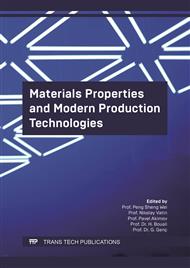[1]
P. H. Frith, Fatigue Tests on Rolled Alloy Steels Made in Electric and Open-Hearth Furnaces, Journal of The Iron and Steel Institute, Vol. 180, pp.26-33, (1955).
Google Scholar
[2]
K. Shiozawa, Y. Morii, S. Nishino and L. Lu, Subsurface crack initiation and propagation mechanism in high-strength steel in a very high cycle fatigue regime, International Journal of Fatigue, 28, pp.1521-1532, (2006).
DOI: 10.1016/j.ijfatigue.2005.08.015
Google Scholar
[3]
Y. Murakami, Metal fatigue: Effects of Defects and Nonmetallic Inclusions, Elsevier Science Ltd, UK, (2002).
Google Scholar
[4]
T. Sakai, Y. Sato, Y. Nagano, M. Takeda and N. Oguma, Effect of stress ratio on long life fatigue behavior of high carbon chromium bearing steel under axial loading, International Journal of Fatigue, 28, pp.1547-1554, (2006).
DOI: 10.1016/j.ijfatigue.2005.04.018
Google Scholar
[5]
R. A. Grange, E. R. Shackelford, U. S. Patent 3, 178, 324, (1965).
Google Scholar
[6]
R. A. Grange, The Rapid Heat Treatment of Steel, Merallurgical Transactions, Vol. 2, pp.65-78, (1971).
Google Scholar
[7]
I. Yoshida, K. Mizobe and K. Kida, Observation of Fracture Surface of Induction-Heated JIS SUJ2 Bearing Steel under Rotating Bending Fatigue, ISSN: 1662-9752, Vol. 904 pp.24-28, (2017).
DOI: 10.4028/www.scientific.net/msf.904.24
Google Scholar
[8]
E. C. Santos, K. Kida T. Honda, H. Koike and J. Rozwadowska, FATIGUE STRENGTH IMPROVEMENT OF AISI E52100 BEARING STEEL BY INDUCTION HEATING AND REPEATED QUENCHING, Materials Science, Vol. 47, No. 5, pp.677-682, (2012).
DOI: 10.1007/s11003-012-9443-8
Google Scholar
[9]
H. Koike, E. C. Santos, K. Kida T. Honda and J. Rozwadowska, Effect of repeated induction heating on fatigue crack propagation in SAE 52100 bearing steel, Advanced Materials Research, Vols. 217-218, pp.1266-1271, (2011).
DOI: 10.4028/www.scientific.net/amr.217-218.1266
Google Scholar
[10]
K. Mizobe, E. C. Santos, T. Honda, H. Koike and K. Kida, Observation of non-metallic inclusions on repeatedly quenched SAE 52100 bearing steel fracture surfaces, International Jornal of Materials and Product Technology, Vol. 44, pp.227-239, (2012).
DOI: 10.1504/ijmpt.2012.050186
Google Scholar
[11]
K. Tsuji, K. Mizobe, and K. Kida, Development of Surface Etching (FSE) Method around Non-Metallic Inclusion of SUJ2 Steel, Material Science Forum, Vol. 971, pp.65-69, (2019).
DOI: 10.4028/www.scientific.net/msf.971.65
Google Scholar



